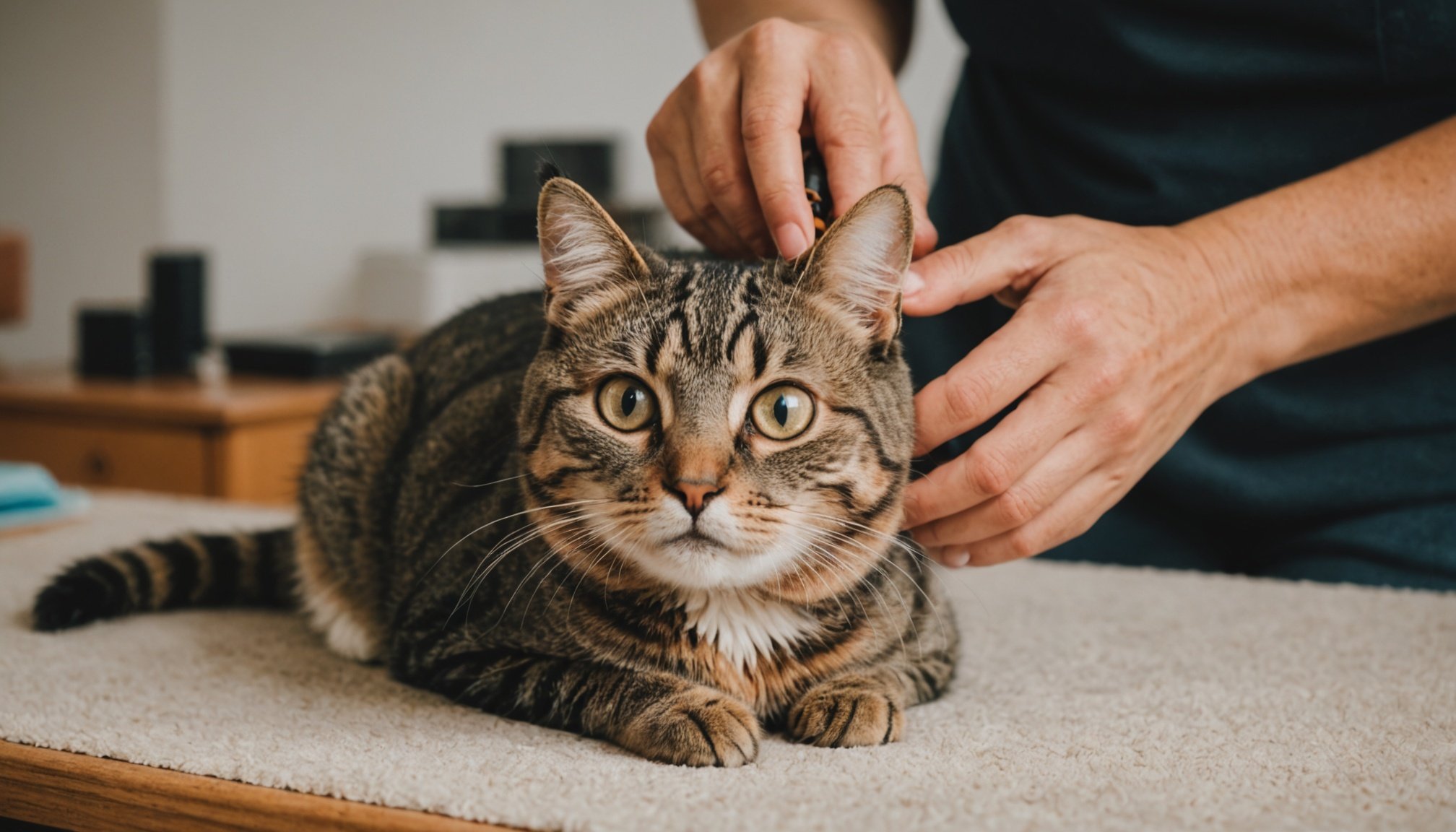Understanding Cat Anxiety
Understanding cat anxiety during activities such as nail trimming is crucial for any cat owner. Nail trimming can be a source of significant stress for some cats, indicated by common signs such as hissing, escape attempts, or excessive grooming afterward. These behaviours highlight the need for effective feline stress reduction techniques.
Psychological Factors
The fear associated with nail trimming stems from a few psychological factors. Primarily, it’s an unfamiliar and persistent experience, where the cat feels restrained against its will, triggering a stress response. Some cats may have heightened sensitivity in their paws, leading to discomfort. Furthermore, past traumatic events can exacerbate this fear, fostering a long-term anxiety.
Cela peut vous intéresser : Creating a balanced diet for your hyperthyroid cat: effective strategies for weight management and energy boost
Individual Personalities
It’s vital to understand that each cat possesses a unique personality, which means their response to anxiety-inducing situations can vary greatly. While some cats might remain calm with gradual acclimatization, others may not. Recognizing these nuances allows for a tailored approach to alleviating their stress.
Solution-oriented approaches to help reduce feline anxiety might include gentle handling, positive reinforcement, or consulting a veterinarian specialised in animal behaviour. These methods help in nurturing trust and creating a positive association with the nail-trimming process. Recognising and respecting a cat’s individual needs is a key step toward reducing stress and anxiety during these necessary grooming sessions.
En parallèle : Stress-free strategies for teaching your cat to tolerate nail clipping naturally and comfortably
Creating a Calm Environment
Setting up a calming environment is essential for a successful and stress-free nail trimming session. Begin by choosing a quiet area in your home to reduce any potential distractions. A familiar space can significantly help your pet feel at ease. It’s important to use areas they are accustomed to, fostering a stress-free space.
Introduce familiar scents to the room, possibly by using your pet’s favourite toys or blankets. These items are comforting and can subtly signal that the environment is safe. In addition, scents associated with their normal play or rest periods will reassure them during the task at hand.
Consider the temperature and lighting in the area. Keeping the temperature at a comfortable level—neither too hot nor too cold—ensures your pet remains relaxed. Good soft lighting can also contribute to a soothing atmosphere. Harsh lights might make the pet uneasy, while softer hues can enhance their comfort.
In preparation for nail trimming, dedicating some time to observe how your pet reacts to different stimuli in the space can be advantageous. Adjust elements as needed to create the most supportive environment for both you and your pet, ensuring the trimming process is as smooth and stress-free as possible.
Pre-Trimming Routines
Creating a pre-trimming routine can significantly ease the grooming experience for your cat, transforming a potentially stressful task into a smoother process. The key lies in implementing a gradual desensitization process. This helps your cat become accustomed to the trimming tools and environment over time. Start by letting your cat sniff and inspect the grooming tools during relaxation time, associating these items with positive experiences.
Incorporate cat relaxation techniques such as playing and providing treats before the trimming session. Engaging your cat in play can help expend energy and reduce anxiety, making them more receptive to subsequent grooming activities. Treats can act as a rewarding distraction, reinforcing positive behavior during the trimming process.
Moreover, establishing a consistent schedule for grooming helps build comfort and predictability for your cat. Structure is comforting, especially for animals prone to stress. A familiar routine can become a soothing preparation, signaling what is to come and reducing resistance from your feline friend. Be patient with this process, allowing the cat to adjust at their own pace.
Ultimately, these steps can contribute significantly to a more relaxed atmosphere, promoting a healthier relationship between you and your pet during grooming sessions.
Techniques for Calming during Trimming
Calming your cat during a nail trimming session involves a blend of gentle talk and soothing methods. Approach your feline with a calm voice, as this can help ease any anxiety. Verbal reassurance, combined with a soft, steady tone, can create a more relaxed environment, reducing stress for both you and your pet.
Implementing hands-on techniques is also crucial. For example, holding methods such as wrapping your cat in a towel, known as the “kitty burrito” method, can offer a sense of security. Ensuring your grip is firm yet gentle will prevent any sudden movements while keeping your cat comfortable.
Equipping yourself with the right tools and products can further enhance the experience. Consider using calming sprays as a preparatory step — these sprays often contain pheromones that can soothe anxious cats. Additionally, selecting the appropriate clippers and ensuring they are sharp and clean will make the trimming process smoother and faster, minimizing discomfort.
By integrating these nail trimming tips into your routine, you not only enhance the experience but also encourage your cat to associate nail care with positive, feline relaxation moments.
Safety First
When it comes to cat safety during nail trimming, ensuring a calm and secure environment is paramount. Handling your feline companion gently yet firmly can prevent stress and avoiding injury. It is essential to cradle your cat in a way that supports their body, preventing sudden movements. Encourage a sense of comfort by speaking softly and offering treats before and after the session.
Understanding the signs of distress is crucial. Look for clues such as twitching tails, growling, or excessive struggling. If these signs present themselves, it’s time to stop and reassess. Prolonging the process when your cat is anxious can result in injuries or a negative association with trimming.
Break periods are not only beneficial but necessary. For longer grooming sessions, intersperse them with short breaks to allow your cat to decompress. This approach fosters patience and cooperation, making future sessions smoother.
By employing these best practices, you ensure that the process remains as stress-free and safe as possible for both you and your cat. Maintaining an awareness of your cat’s comfort and encouraging gradual acclimatization is key to successful nail trimming. Understanding your cat’s needs and responses will significantly enhance the experience, building a safer and more trusting relationship.
Expert Recommendations
Understanding how to effectively calm a cat requires expert advice that can be both informative and reassuring. Veterinary insights reveal that ensuring a peaceful environment and using vet-approved techniques can significantly reduce feline stress.
Vet-Approved Techniques
One approach involves creating a safe space. This often means setting up a cozy, quiet spot where your cat can retreat. According to veterinary insights, maintaining such areas can help manage anxiety levels, especially during unsettling events like thunderstorms or house parties.
Recommended Tools
Professional tips also highlight the use of specific products designed to calm cats. Many cat owners and professionals agree on the efficacy of pheromone diffusers as they release calming scents, mimicking natural pheromones that provide comfort. Additionally, interactive toys can serve as great tools to dissipate energy and reduce stress.
Anecdotal Experiences
Anecdotal experiences from both cat owners and vets provide valuable insights. One common story involves a simple cardboard box turning into a sanctuary for a stressed feline. Owners report that such solutions, simple yet effective, often work wonders in soothing their furry friends. By incorporating expert advice, veterinary insights, and professional tips into your routine, you can foster a comforting environment that supports your cat’s well-being.
Visual Aids and Resources
Visual aids play a crucial role in mastering techniques such as cat nail trimming. Video demonstrations provide a visual guide, allowing viewers to follow along and gain a clearer understanding of the process. They help in breaking down the steps into manageable parts, making it easier to learn and apply.
When it comes to locating instructional videos, platforms like YouTube are invaluable. Many professional groomers and veterinarians share their expertise through detailed guides and demonstrations. These videos often cover everything from selecting the right tools to ensuring your cat remains calm throughout the process. It’s wise to choose videos that are well-reviewed and potentially endorsed by professionals.
Additionally, calming resources are important for both the pet and the owner. These can include techniques shown in videos or even specific strategies discussed in blog posts about pet grooming. Calming resources help create a stress-free environment, which is pivotal for successful grooming.
Images and diagrams that show proper techniques for cat handling are another invaluable resource. By visually demonstrating the correct way to hold and position your cat, these images can significantly reduce any potential anxiety both you and your cat may experience. Collectively, these resources contribute to a more informed and confident approach to grooming tasks.










